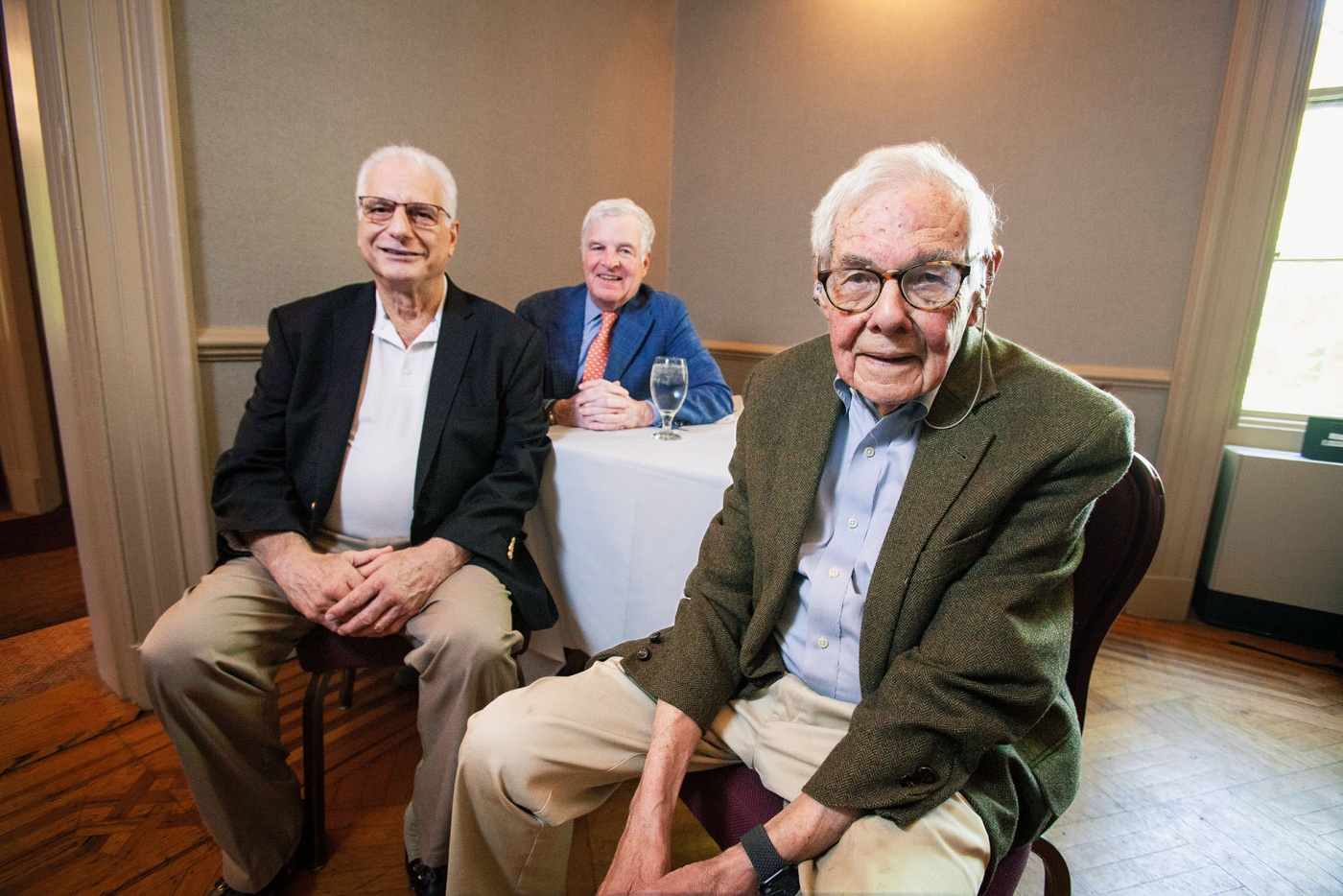Dean Barrett Hazeltine rolls up to the Brown Faculty Club on his bicycle, wearing a brown tweed jacket, khaki pants, and round tortoise shell glasses. Having forgotten his lock at home, he rests his bike on a fence out back. Inside, he reunites with Joe Martino ’74 and Jamie Kiernan ’74 at a table tucked in the corner by the bar. “We’re not going to have beer?” he asks with a smile, punctuating the buzz of conversation from the other tables. The pair laugh and order three Heinekens, catching up like the old friends they are.
This lunch, coinciding with the beginning of Reunion Weekend, is a celebration of the 50th year of ENGN 9, Management of Industrial and Nonprofit Organizations, now called ENGN 90. Kiernan described the class as responsible for unleashing “a wave of entrepreneurial enthusiasm at Brown.” Both the class and Hazeltine have become legendary. Kiernan describes Hazeltine as a “rock star.” After Hazeltine won an award from the senior class for excellence in teaching twelve years in a row, the University renamed the award in his honor. Over lunch, the trio reminisce about the founding and impact of the course.
In the spring of 1974, as Kiernan, who studied history, and Martino, who studied engineering, approached graduation, the pair became increasingly concerned with finding a job. Kiernan remembers the bleak economic circumstances, including gas rationing. Since there was not an existing managerial course at Brown, they approached Hazeltine, who was then the associate dean of the college, about creating one. Kiernan recalls that Hazeltine was immediately supportive, saying “Well, go for it.” “Only at Brown would a class about entrepreneurship be in the engineering department, because of Hazeltine,” Kiernan laughs. “It shook up the rest of the Ivy League because entrepreneurship was embedded in the New Curriculum at Brown.”
Kiernan and Martino, who met at football preseason before their freshman year, crafted the curriculum during the second semester of their senior year with Hazeltine’s support. They attended classes at the Harvard Business School, and Martino fondly remembers the trips to Cambridge in Kiernan’s sports car. They were inspired by the case studies discussed and eagerly brought that method back to Brown. “When we came back, we had a skeleton,” Kiernan explains. “Working with Hazeltine, he put the flesh on it, figuring out how one would address a college course.” “Hazeltine put the meat on the bones,” Martino adds with a laugh. The beloved professor has been teaching the class for 50 years. “Each case is a liberal arts example because it involves people, objectives, strategy, and an understanding of the culture,” Hazeltine explains. These case studies are designed to prompt students to think through everyday problems that businesses face in the real world. For example, Kiernan remembers a case in which the student is told that they are the advisor to the CEO of a chain of restaurants, and in this hypothetical scenario in which margins are under pressure, the student is given 48 hours to come up with recommendations. There is no correct answer, and students are encouraged to disagree and discuss with each other. “The real focus was on action and planning a strategy and a set of steps,” Hazeltine explains. “That was different than most courses.” He says that many courses ask students to simplify a problem into an essential idea, but “you can’t do that in management.”
While the trio agrees that the methodology of the class facilitates practical learning, they also celebrate how the course provides students with an opportunity to learn from people in the field. Over the years, Hazeltine has brought in many business practitioners and entrepreneurs to speak to the class such as representatives from Textron and Texas Instruments. Some guest speakers, like Thomas J. Watson Jr. ’37, president and CEO of International Business Machines (IBM), are Brown alumni. By learning from experienced entrepreneurs and business practitioners, Hazeltine says that the course encourages students to “go out and try and do a lot of very interesting things.” Martino was one such guest lecturer. He was working in consumer product marketing at the time and describes it as a “dream come true” to stand in front of a lecture hall of several hundred people. He says it was “such a thrill for me to be back at school, to be with Hazeltine, and to meet the students.”
During the lunch, two former students recognize and approach Hazeltine, thanking him for how meaningful the class was to them. “Those students remember Hazeltine’s support and have always come back ever true to Brown and are fiercely loyal to this program of entrepreneurship,” Kiernan says. In fact, Hazeltine fans cause a logjam every year at Commencement as they jockey to greet the not-really-retired professor, who turns 93 in November.
Both Kiernan and Martino feel a sense of personal gratitude to Hazeltine and ENGN 9. After Brown, Kiernan went to Harvard Business School and Martino attended Wharton Business School, and Martino explains that developing the course gave him a “taste of what it would be like.” Kiernan adds that a letter of recommendation from Hazeltine “populated us at all the best business schools.” Kiernan and Martino both found success. Martino is the operating partner of Milwaukee’s Stevens Point Brewery; Kiernan was formerly president of Goldman Sachs Canada Inc.
The trio attempts to gather as often as they can. Martino tries to return to campus for the “important reunions ending in zero.” Kiernan occasionally catches Brown football games with Hazeltine, who is an avid college sports fan. Hazeltine, Kiernan, and Martino all believe the now-classic course is as relevant today as it was 50 years ago. Kiernan points to the lecture halls, packed semester after semester, as evidence that students today still view ENGN 9 as “real world experience [they’re] not getting anywhere else.”




